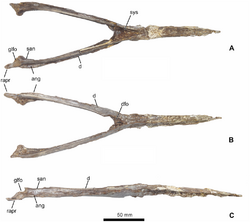Biology:Aymberedactylus
| Aymberedactylus | |
|---|---|

| |
| Holotype mandible | |
| Scientific classification | |
| Domain: | Eukaryota |
| Kingdom: | Animalia |
| Phylum: | Chordata |
| Order: | †Pterosauria |
| Suborder: | †Pterodactyloidea |
| Family: | †Tapejaridae |
| Genus: | †Aymberedactylus Pêgas et al., 2016[1] |
| Species: | †A. cearensis
|
| Binomial name | |
| †Aymberedactylus cearensis Pêgas et al., 2016[1]
| |
Aymberedactylus (meaning "small lizard finger") is a genus of tapejarid pterosaur from the Early Cretaceous Crato Formation of Brazil .[1] It contains a single species, A. cearensis.
Discovery and naming
The holotype specimen of Aymberedactylus, MN 7596-V, is a nearly complete mandible preserved in three dimensions. It was discovered in the Aptian-Albian Crato Formation, a konservat-lagerstätte well known for its exquisite preservation of fossils,[2] and it was described in 2016.[1]
The name Aymberedactylus is derived from the Tupi word aymbere ("small lizard") and Greek Script error: The function "transl" does not exist. ("finger"), and the specific name refers to the Brazilian state of Ceará, which it was discovered in.[1]
Description
Aymberedactylus can be identified as a tapejarine tapejarid from the holotypic jawbone due to its toothlessness, slightly downturned dentary symphysis which accounts for half of the total length of the jaw, and a small crest on the bottom of the dentary (which was incompletely preserved). Small neurovascular foramina on the symphysis indicates the likely presence of a horned sheath over the tip of the jaw, which is also seen in Tupandactylus. The preserved portion is 270 millimetres (11 in) long.[1]
It can be distinguished from other pterosaurs by a long retroarticular process (a process to which the depressor mandibulae muscle attaches, implying that Aymberedactylus had good control over the movement of its jaw bones) and a small fossa, or depression, with a roughened bone texture on the splenial bone. In addition, Aymberedactylus shows a unique combination of traits: the shelf on the dentary symphysis is deep, the dorsal rim of the symphysis is concave, the jaw is relatively wide, the dentary fossa is short and shallow (which indicates a relatively weak bite), and the mandibular rami form a very large angle with the symphysis. These traits are a unique combination of basal and derived characteristics within Tapejaridae.[1]
The preserved specimen of Aymberedactylus would have had a wingspan of approximately 2 metres (6 ft 7 in), typical of tapejarids. Judging by how the bones in its skull were not yet entirely fused, it was likely a subadult.[1]
Phylogeny
A phylogenetic analysis conducted in 2016 recovered Aymberedactylus as the most basal tapejarine.[1]
| Tapejarinae |
| ||||||||||||||||||||||||||||||||||||
References
- ↑ 1.0 1.1 1.2 1.3 1.4 1.5 1.6 1.7 1.8 Pêgas, R.V.; Leal, M.E.d.; Kellner, A.W.A. (2016). "A Basal Tapejarine (Pterosauria; Pterodactyloidea; Tapejaridae) from the Crato Formation, Early Cretaceous of Brazil.". PLOS ONE 11 (9): e0162692. doi:10.1371/journal.pone.0162692. PMID 27655346. Bibcode: 2016PLoSO..1162692P.
- ↑ Unwin, D.M.; Martill, D.M. (2007). "Pterosaurs of the Crato Formation.". in Martill, D.M.. The Crato Fossil Beds of Brazil: Window into an Ancient World. Cambridge: Cambridge University Press. pp. 475–524. ISBN 978-0-521-85867-0. https://archive.org/details/cratofossilbedsb00mart.
Wikidata ☰ Q26995217 entry
 |



